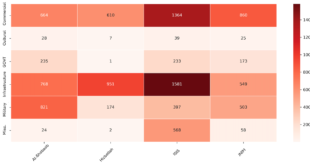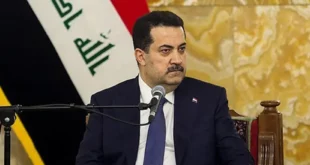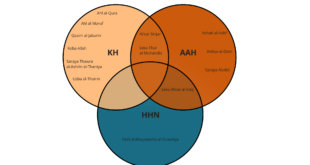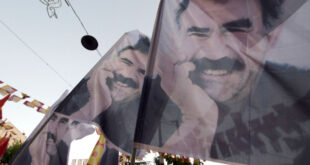
Despite internal criticism over Beirut port blast and Hariri tribunal, Nasrallah does not stray from strict policy of retaliation.
Following the August 4 Beirut port disaster, the Israel military lifted the intelligence warning of a possible attack on the border with Lebanon, and lowered the alert level. The reason was simple: Even though Hezbollah had not yet settled the score over the death of one of its senior officials in Damascus on July 20, in an airstrike attributed to Israel, the explosion had entirely changed the Lebanese context. The thought was that the Shi’ite organization, which is seen as part of a corrupt political and governmental system in Lebanon, should not compound the country’s suffering by turning up the heat at the Israeli border.
Maj. Gen. Amir Baram, the head of the IDF’s Northern Command, is known for being stubborn. He dug in his heels, and after a few days he persuaded the entire defense establishment to restore the intelligence warning and the high alert in the north. On Tuesday night, he was apparently proved right. Israeli troops near the border around Kibbutz Manara were fired upon from Lebanon. No one was injured, but it led the Israeli Air Force to take the unusual step of bombing Hezbollah positions on the Lebanese side of the border. For the second time in a month, Hezbollah had failed in its attempt at revenge. It is reasonable to believe its efforts will continue.
Baram has a long history of tactical incidents with Hezbollah under his belt, first as a special unit commander and later as a division commander. For the most part, he came out on top following a considerable number of exploits. But he also knows that not everything is within his control.
Israel’s borders with Lebanon and Syria are long. Not all of the units deployed along the border are disciplined, elite units, and Murphy’s Law works overtime in ongoing security operations. If something can go wrong, it probably will. That is the basis for Baram’s insistence over continuing to keep the command’s units on alert, despite the time that has elapsed and despite the disaster in Beirut.
The Northern Command’s assessment relied on analyzing Hezbollah leader Hassan Nasrallah’s stance. In recent years, and dozens of speeches, he has tried to establish a “balance of deterrence” vis-à-vis Israel that has positioned Hezbollah as a defender of Lebanon. He has threatened that Hezbollah will respond to every Lebanese death caused by the IDF. If the Israeli air force bombed Beirut’s Shi’ite neighborhood of Dahiyeh, Israel’s “Pentagon” in Tel Aviv would be bombed, and Hezbollah would retaliate for damage to state infrastructure in Lebanon by hitting strategic sites in Israel. Nasrallah has not strayed from that policy in recent years any time that his people have been hit.
That was the case in 2015, after Hezbollah member Jihad Mughniyeh was assassinated in the Syrian Golan Heights, about two years after the assassination of Samir Kuntar – and exactly a year ago, after Israel killed two Lebanese members of a cell that attempted to carry out an attack using drones from the Syrian border in the Golan. (That night, there was an airstrike on Dahiyeh for which Israel did not claim responsibility.)
In all of these incidents, Hezbollah responded by firing missiles at tanks or detonating explosives aimed at Israeli forces on the Lebanese border. In some cases, weeks went by before the militia organization found a weak spot in the army’s deployments, taking advantage of the opportunity and attacking.
That’s what happened this time around as well. A week after the attack in Damascus, Hezbollah dispatched a three-man cell to the Gladiola outpost on Har Dov. But Hezbollah acted very much out of character: The cell set out alone, without backup that could rescue or assist it, other than a getaway vehicle awaiting the cell members on their way back. It’s reasonable that Hezbollah was concerned that the deployment of additional forces would reveal their intentions to Israeli intelligence.
The Lebanese fighters were spotted climbing in the complex terrain on the way up the mountain, where there is no border fence. The IDF dropped bombs near them, fired at them using tanks and sharpshooters. Israeli brass gave orders, in consultation with political officials, to make do with warning shots alone. The three cell members fled back down the slope, leaving behind a sniper’s rifle.
There was another attempt on August 3 on the border in the Golan Heights. This time it was a Syrian cell deployed by the Iranians, and it apparently came to settle a different score, over a series of assaults attributed to Israel against Iranian interests in Syria and perhaps even in Iran itself. The cell members came to lay explosive devices for Israeli forces near the border fence. This time lethal weapons fire was directed at them. Sharpshooters from the elite Maglan reconnaissance unit and IAF planes killed the four.
Following that, no other attempts were apparently made, until Tuesday. It appears that the prior attempt at the Gladiola outpost simply spurred Hezbollah on to try again, despite the domestic situation.
Israeli conduct remained relatively cautious and restrained, considering what was at stake. The tourist season in the north is at its height, following the first coronavirus wave and the lockdown, which paralyzed the tourism sector entirely during the spring. With most international flights from Israel also grounded, bed-and-breakfasts in the area are fully booked. And school starts in another week against the backdrop of the pandemic.
Across the border, Lebanon is in a particularly sensitive period, and on top of the pandemic, now has to cope with the consequences of the destruction wreaked by the port blast. Because the weapons fire Tuesday night didn’t produce results, we need to assume that Hezbollah will make additional attempts. These efforts are being carried out in a defined area – near the border and against Israeli army forces and not Israeli civilians.
Nasrallah is not interested in igniting a conflagration at the moment, despite his tough rhetoric. For its part, Israel is seeking to pursue its actions in Syria in the so-called campaign between wars, as well as maintaining a balance of deterrence in its favor vis-à-vis Hezbollah. In a pessimistic scenario, Hezbollah’s next acts in response could also lead to casualties on the Israel side and even deteriorate into several “days of battle,” exchanges of fire below the level of war, along the Lebanese border.
Hezbollah hit squad
It will take a lot more time and huge investments to repair the disaster damage at the Beirut port. The Shi’ite community suffered relatively less than the Sunni Muslim and Christian communities, because the blast was relatively far away from the southern neighborhoods where most of Beirut’s Shi’ites live.
But Hezbollah is currently the target of intense political and media criticism over its role in the corrupt and inefficient system that controls Lebanon. And the fact that the Shi’ite militia organization itself has stores of weapons and ammunition in the middle of population centers doesn’t endear Hezbollah to the country’s other religious communities.
On the other hand, Hezbollah escaped in good shape in the strange verdict issued this month by the international UN-sponsored tribunal on the 2005 assassination of former Lebanese Prime Minister Rafik Hariri. After an 11-year investigation, the tribunal concluded that there wasn’t convincing evidence of Hezbollah’s involvement in the explosion that killed Hariri and 21 other people in Beirut.
The verdict singled out Salim Jamil Ayyash, a Hezbollah member, as the only culprit. Three other Hezbollah members were cleared.
The verdict apparently sufficiently angered the American intelligence community and other agencies in Europe and the Middle East that they leaked details regarding Ayyash’s actions to the Washington Post. On Tuesday, the newspaper reported that Ayyash was a member of a Hezbollah hit squad called Unit 121, which is still operating. Ayyash, whose whereabouts are unknown, was also a commander of the unit.
The newspaper quotes American intelligence officials who claim that Hariri’s assassination was carried out on explicit orders from Nasrallah to the hit squad, which also carried out the killing of four other Lebanese who got in the way of Hezbollah’s interests between 2007 and 2013.
One of its victims was Wissam Eid, a Lebanese intelligence officer who in 2006, with the help of signal intelligence capabilities that Lebanon acquired from the United States after the Second Lebanon War, managed to untangle the network of connections among the members of the group behind Hariri’s killing. Eid himself was killed in 2008, but even the United Nations has not been able to bring Hariri’s killers to justice.
 Eurasia Press & News
Eurasia Press & News



